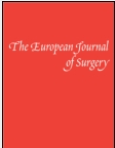Perforating appendicitis: is it a separate disease?
Abstract
Objective:
To find out whether perforated and unperforated appendicitis are separate diseases and can be distinguished clinically.
Design:
Prospective multicentre study.
Setting:
11 departments of surgery in Germany and Austria.
Subjects:
519 patients over 6 years old who had histologically confirmed acute appendicitis between October 1994 and March 1996.
Main outcome measures:
Differences in history, clinical findings, lab results, clinical course and outcome.
Results:
92 of the 519 patients (18%) had perforated appendicitis. The following variables were shown by univariate analysis to be significantly more common in the group with perforated appendicitis: rigiditiy, reduced abdominal wall movement, abdominal distension, reduced bowel sounds (all p < 0.001), pale skin (p < 0.005), generalised abdominal tenderness, severe abdominal tenderness (both p < 0.01), WCC ≥ 109/L (p < 0.05). By multivariate analysis the following variables were significantly more common in the group with perforated appendicitis: age over 50 years (p < 0.0001); change in bowel habit and rigidity of the abdominal wall (both p = 0.001); generalised tenderness (p < 0.01); male sex (p < 0.01); and distended abdomen (p < 0.05). Rectal examination failed to make the distinction.
Conclusions:
Perforated and unperforated appendicitis behave clinically like two different diseases. They can in most cases reliably be distinguished using clinical criteria alone. Although greater diagnostic accuracy may result in a higher rate of perforation, close observation and timely intervention will only marginally affect the outcome. Copyright © 1999 Taylor and Francis Ltd.




